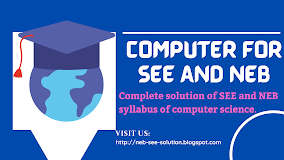New Syllabus of Computer Science for Grades 9 and 10 by CDC, Nepal
The Curriculum Development Centre (CDC), Nepal, has introduced an updated syllabus for grades 9 and 10, designed to provide students with a robust foundation in both traditional academics and modern technological skills. This forward-looking curriculum not only ensures students grasp essential theoretical concepts but also empowers them to apply this knowledge in practical and real-world scenarios.
Why This Syllabus Update Matters
Education systems globally are evolving to address the growing importance of technology, digital literacy, and critical thinking. The revised curriculum by CDC is a significant step towards equipping Nepal’s students with the tools they need to succeed in a competitive and dynamic world. By blending traditional learning methods with contemporary topics, the syllabus prepares students for higher education and future career opportunities.
Core Features of the Updated Syllabus
Comprehensive Learning Structure
- The curriculum is organized into competencies, learning outcomes, content sequences, and student assessments.
- It ensures a balance between theoretical learning (64 hours) and practical activities (64 hours), creating a well-rounded educational experience.
Modern and Relevant Topics
- Contemporary fields like Artificial Intelligence (AI), cybersecurity, Python programming, web technology, and multimedia have been included, giving students a competitive edge.
- Emerging areas like IoT, cloud computing, and data visualization tools ensure students remain updated with global technological advancements.
Balanced Evaluation System
- Internal evaluation (50%) includes practical tasks, projects, and classroom participation.
- External exams (50%) focus on understanding, application, and higher-order thinking skills, assessed through a mix of theory and practical tests.
Subject Highlights for Grade 9
1. Computer System
Students delve into the structure of computer systems, exploring input/output devices, memory, and software. Practical tasks, like assembling parts and identifying components, provide hands-on experience.
2. Number System
Binary, octal, and hexadecimal systems are introduced, with a focus on conversions and calculations. Practical tools like online converters make these concepts easier to grasp.
3. Block Programming
Students engage with block-based coding platforms such as MIT Scratch to create interactive projects, including games and animations. Advanced topics, like microcontrollers and Arduino basics, are also introduced.
4. Web Technology
Basics of HTML and CSS are covered to enable students to create simple, visually appealing web pages. Concepts like user experience (UX) design and web development cycles are explored.
5. Internet and Social Media
This unit introduces students to the World Wide Web, browsers, search engines, and email. They also learn safe social media practices and the responsible use of digital tools.
6. Cybersecurity and Digital Citizenship
Key topics include understanding cyber threats, safe browsing practices, and creating strong passwords. Students also explore the ethical aspects of digital citizenship, such as maintaining positive digital footprints.
7. Programming Concepts in Python
Python programming is introduced, focusing on the fundamentals: variables, data types, operators, and loops. Students learn to write and debug basic code, fostering problem-solving skills.
Subject Highlights for Grade 10
1. Computer Networks and Communication
This unit teaches networking concepts, including types of networks (LAN, WAN), network devices (routers, hubs), and protocols. Students also learn to configure basic network settings and troubleshoot using commands like ping and ipconfig.
2. Database Management System (DBMS)
Students explore database concepts, SQL commands, and relationships between tables. Practical tasks include creating and manipulating databases using open-source tools like MySQL.
3. Multimedia
Key topics include image, audio, and video editing using tools like Pixlr and Audacity. Students also explore multimedia file formats and create projects combining text, graphics, sound, and video.
4. Python Programming
This unit builds on the basics, introducing file handling, user-defined functions, and data visualization with libraries like Pandas and Matplotlib. Students create projects, such as calculators or visualizations, to showcase their coding skills.
5. AI and Contemporary Technologies
Students are introduced to AI concepts, including generative AI tools (like ChatGPT and Copilot), machine learning techniques, IoT, and extended reality (XR). Ethical considerations in AI, such as bias and privacy, are also discussed.
Teaching and Learning Approaches
The curriculum emphasizes active learning through the following strategies:
- Project-Based Learning (PBL): Students engage with real-world challenges, designing and implementing projects.
- Gamification: Coding challenges, competitions, and rewards foster enthusiasm and engagement.
- Collaborative Learning: Group projects and peer mentorship promote teamwork and knowledge sharing.
- Practical Labs: Hands-on coding and experiments build confidence and deepen understanding.
Evaluation Framework
Internal Evaluation
- Includes participation (5%), practical activities and projects (35%), and trimester tests (10%).
- Students document their work and present projects to enhance communication and organizational skills.
External Evaluation
- Focuses on theoretical exams that test understanding, application, and higher-order thinking skills.
- Questions are based on Bloom’s taxonomy, ensuring a comprehensive assessment of learning.
Complete Syllabus
Conclusion
The new syllabus for grades 9 and 10 by CDC, Nepal, is a transformative step towards preparing students for the future. It balances foundational knowledge with cutting-edge technology, fostering creativity, critical thinking, and problem-solving abilities.
By embracing this curriculum, Nepal's education system is not just keeping pace with global trends but also empowering its students to be innovators and leaders of tomorrow. Schools, educators, and parents must collaborate to ensure the successful implementation of this curriculum, creating a generation ready to face modern challenges with confidence and competence.
This comprehensive syllabus is a milestone in Nepal's educational journey, paving the way for a brighter and technologically advanced future.







.png)


.png)



.png)

.png)
.png)

No comments:
Post a Comment